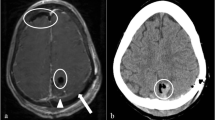Abstract
Background
The prevalence of encephalocele is estimated to be 0.8–5.0 per 10,000 live births. The most frequent encephalocele is the occipital encephalocele. It is a congenital neural tube defect characterized by the protrusion or herniation of intracranial contents through a cranial defect. The term “giant/massive/large encephalocele” is used to describe an encephalocele that is significantly larger than the size of the head.
Case description
A 2-month-old male infant presented in the neurosurgery outpatient department with one of the largest head masses over the posterior aspect since birth. The swelling was gradually progressive and developed ulceration over the swelling with intermittent cerebrospinal fluid (CSF) discharge but no associated weakness in limbs. Magnetic Resonance Imaging (MRI) brain showed a large occipital meningoencephalocele containing predominantly cyst with part of the cerebellar and occipital lobe. The surgery was planned. The sac contained CSF with the gliotic occipital lobe. The sac and gliotic brain tissue was excised. He had an uneventful postoperative course.
Conclusion
Surgery serves several functions, including reducing the torque and weight of the head to allow for more normal motor development, removal of the thin, leaking scalp and dural closure to prevent CSF leak and subsequent infection, and improving the cosmetic and social issues that the child and family may have to endure.


Similar content being viewed by others
References
Cavalheiro S, da Costa MDS, Mendonça JN, Dastoli PA, Suriano IC, Barbosa MM, Moron AF (2017) Antenatal management of fetal neurosurgical diseases. Childs Nerv Syst 33(7):1125–1141. https://doi.org/10.1007/s00381-017-3442-x
Ghritlaharey RK (2018) A brief review of giant occipital encephalocele. J Neurosci Rural Pract 9(4):455–456. https://doi.org/10.4103/jnrp.jnrp_189_18
Satyarthee GD, Moscote-Salazar LR, Escobar-Hernandez N, Aquino-Matus J, Puac-Polanco PC, Hoz SS, Calderon-Miranda WG (2017) A giant occipital encephalocele in neonate with spontaneous hemorrhage into the encephalocele sac: surgical management. J Pediatr Neurosci 3:268–270
Loya J, Brown NJ, Gonda D, Levy M (2023) Challenging, giant occipital encephalocele in a pediatric Saipanese male. Clin Case Rep 11(5):e7380
Naik V, Marulasiddappa V, Gowda Naveen MA, Pai SB, Bysani P, Amreesh SB (2019) Giant encephalocoele: a rare case report and review of literature. Asian J Neurosurg 14(1):289–291
Bulut MD, Yavuz A, Bora A, Gülşen I, Özkaçmaz S, Sösüncü E (2013) Chiari III malformation with a giant encephalocele Sac: case report and a review of the literature. Pediatr Neurosurg 49(5):316–319
Nath HD, Mahapatra AK, Borkar SA (2014) A giant occipital encephalocele with spontaneous hemorrhage into the sac: a rare case report. Asian J Neurosurg 9(3):158–160
Chaturvedi J, Goyal N, Arora RK, Govil N (2018) Giant occipitocervical encephalocele. J Neurosci Rural Pract 3:414–416
Acknowledgements
The authors acknowledge all professors and consultants in the Department of Neurosurgery for the guidance and assistance.
Author information
Authors and Affiliations
Contributions
Anand Kumar Das and Saraj Kumar Singh contributed equally to the manuscript preparation. The first draft of the manuscript was written by Anand Kumar Das. Both authors commented on previous versions of the manuscript. Both authors read and approved the final manuscript.
Corresponding author
Ethics declarations
Ethical approval
Not required.
Consent to participate
Written informed consent was obtained from the parents for the publication of images.
Conflict of interest
All authors certify that they have no affiliations with or involvement in any organization or entity with any financial interest or non-financial interest in the subject matter or materials discussed in this manuscript.
Additional information
Publisher's Note
Springer Nature remains neutral with regard to jurisdictional claims in published maps and institutional affiliations.
Rights and permissions
Springer Nature or its licensor (e.g. a society or other partner) holds exclusive rights to this article under a publishing agreement with the author(s) or other rightsholder(s); author self-archiving of the accepted manuscript version of this article is solely governed by the terms of such publishing agreement and applicable law.
About this article
Cite this article
Das, A.K., Singh, S.K. A rare case of occipital encephalocele presenting as the largest congenital head mass in an infant. Childs Nerv Syst 40, 253–256 (2024). https://doi.org/10.1007/s00381-023-06085-x
Received:
Accepted:
Published:
Issue Date:
DOI: https://doi.org/10.1007/s00381-023-06085-x




